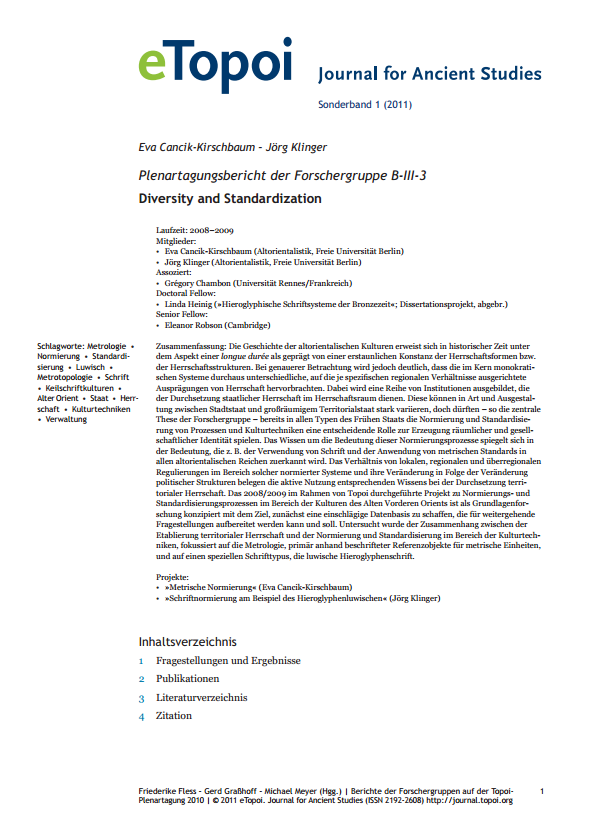Diversity and Standardization
From the historiographic perspective of the longue durée, the history of the cultures of the ancient Near East appear to have been shaped by astonishingly durable forms of governance or structures of authority. Upon closer examination, however, it becomes clear that these essentially monocratic systems engendered highly divergent forms of authority, each oriented to a specific set of regional relations. This process produced a series of institutions which served to implement governmental authority in specific territories. In style and configuration, these types varied dramatically between the city state and the large-scale territorial state, yet at the same time (and this is the central thesis of our research group), processes of norming and standardization played a decisive role in generating spatial and societal identity in every type of early state. An awareness of the significance of such processes of normativity is reflected in the significance attributed for example to the utilization of texts and the application of metric standards in all ancient Near Eastern kingdoms. The relationship between local, regional, and supraregional regulations in the context of such standardizing systems and their transformations in the wake of changing political structures testify to the active deployment of commensurate knowledge in the assertion of territorial authority. A project on norming and standardization processes in the cultures of the ancient Near East, carried out in 2008/2009 in the framework of Topoi, was conceived as basic research whose initial objective was to generate a data- base that could be reconfigured in the context of the examination of subsequent issues. Investigated here is the relationship between the establishment of territorial authority and norming and standardization in the realm of cultural techniques, with a focus on metrology, primarily on the basis of reference objects bearing inscriptions pertaining to metrical units, and on a special type of writing, specifically Hieroglyphic Luwian.
Die Geschichte der altorientalischen Kulturen erweist sich in historischer Zeit unter dem Aspekt einer longue durée als geprägt von einer erstaunlichen Konstanz der Herrschaftsformen bzw. der Herrschaftsstrukturen. Bei genauerer Betrachtung wird jedoch deutlich, dass die im Kern monokratischen Systeme durchaus unterschiedliche, auf die je spezifischen regionalen Verhältnisse ausgerichtete Ausprägungen von Herrschaft hervorbrachten. Dabei wird eine Reihe von Institutionen ausgebildet, die der Durchsetzung staatlicher Herrschaft im Herrschaftsraum dienen. Diese können in Art und Ausgestaltung zwischen Stadtstaat und großräumigem Territorialstaat stark variieren, doch dürften – so die zentrale These der Forschergruppe – bereits in allen Typen des Frühen Staats die Normierung und Standardisierung von Prozessen und Kulturtechniken eine entscheidende Rolle zur Erzeugung räumlicher und gesellschaftlicher Identität spielen. Das Wissen um die Bedeutung dieser Normierungsprozesse spiegelt sich in der Bedeutung, die z. B. der Verwendung von Schrift und der Anwendung von metrischen Standards in allen altorientalischen Reichen zuerkannt wird. Das Verhältnis von lokalen, regionalen und überregionalen Regulierungen im Bereich solcher normierter Systeme und ihre Veränderung in Folge der Veränderung politischer Strukturen belegen die aktive Nutzung entsprechenden Wissens bei der Durchsetzung territorialer Herrschaft. Das 2008/2009 im Rahmen von Topoi durchgeführte Projekt zu Normierungs- und Standardisierungsprozessen im Bereich der Kulturen des Alten Vorderen Orients ist als Grundlagenforschung konzipiert mit dem Ziel, zunächst eine einschlägige Datenbasis zu schaffen, die für weitergehende Fragestellungen aufbereitet werden kann und soll. Untersucht wurde der Zusammenhang zwischen der Etablierung territorialer Herrschaft und der Normierung und Standardisierung im Bereich der Kulturtechniken, fokussiert auf die Metrologie, primär anhand beschrifteter Referenzobjekte für metrische Einheiten, und auf einen speziellen Schrifttypus, die luwische Hieroglyphenschrift.

